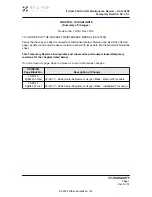
THRUSH AIRCRAFT, INC – MODEL S2R-R1340
AIRCRAFT MAINTENANCE MANUAL
Effective: 01/01/08
1-5
construction and are hinged on ball
bearings. The flaps are electrically
operated by push rods and are completely
sealed against chemical entry. Flap
hinges are stainless steel.
EMPENNAGE
The horizontal stabilizer, elevator, rudder
and vertical fin are an all-metal structure.
All skins, ribs and leading edges are
constructed from alclad material. The
movable surfaces are hinged on sealed
bearings that can be easily replaced. The
rudder and the elevator have aerodynamic
balances that are protected by overhangs
on the fixed surfaces.
COCKPIT
There are two choices of the enclosed
cockpit canopies for the Thrush S2R-
R1340 (1) the SINGLE cockpit canopy or
(2) the DUAL cockpit canopy. The
overturn structure of both is exceptionally
strong and welded to "hard points" in the
fuselage frame. The forward bracing
supports the windshield support channels
and is welded to a lateral tube that is
curved to provide more head clearance.
The fiberglass canopy shell has extra
thickness on the top portion and is well
attached to the extra large steel tube
structure so that it will serve as a skid in
case of overturn. The large canopy doors
permit easy entrance to one or both
cockpits. The doors should not be
removed for flight, as the aircraft
performance will be degraded. The
cockpit seat belts are anchored to the seat
structure, and the shoulder harnesses are
secured to a steel channel at the bottom of
the seat structure. The seats adjust
vertically. The rudder pedals adjust fore
and aft. The windshield is a three-piece
construction. The center section is
tempered safety plate glass for better
resistance to scratching and bird strikes.
The windshield side panels are Plexiglas
and are curved to provide streamlining.
AIRCRAFT SYSTEMS
HYDRAULIC SYSTEMS
The hydraulic system consists of two
master brake cylinders with hydraulic lines
connecting the master cylinders to the
wheel brake cylinders. Applying toe
pressure on the rudder pedals actuates the
master cylinders, which are located above
and just aft of the pilot’s rudder pedals. A
small reservoir is incorporated within each
master cylinder to supply the system with
brake fluid.
POWER PLANT & PROPELLER
The Thrush S2R-R1340 is powered by the
Pratt & Whitney R1340–AN1, –S3H1 or –
S1H1 nine-cylinder supercharged Wasp
radial engine. The propeller is a constant
speed Hamilton Standard 12D40 hub with
all metal 6101-12 or EAC AG-100-2
blades.
This combination provides takeoff power of
600 BHP at 2250 RPM. The engine mount
is a welded chrome-moly tube truss, stress
relieved after welding. The engine is
attached to the mount through rubber
vibration isolators.
Accessibility for servicing and inspection in
the engine compartment is exceptional. A
large access door is provided on the left
side, and cowl panels are easily removed
for full access.
FUEL SYSTEM
A 133-gallon (useable) fuel supply is
available for the Thrush S2R-R1340.
Sixty-eight gallons of fuel is contained in
an integral wing tank (wet wing) just
outboard of the wing root. The left wing
and right wing fuel tanks are
interconnected through a 4.5 U.S. gallon
header tank that is located in the fuselage.
The fuel supply line to the engine is routed
from the header tank outlet finger screen
through a fuel shutoff (on/off) valve to an
electric driven fuel boost pump.














































